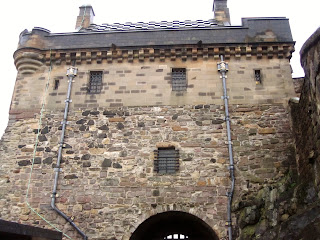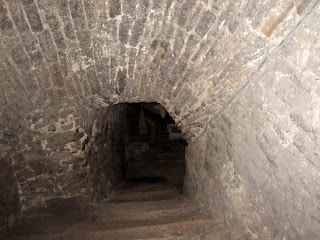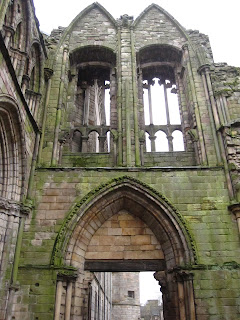11/22/12: Edinburgh Castle
(Located in Edinburgh, Scotland)
How best to spend Thanksgiving Day in another country? Tour a castle of course!
With initial construction beginning in the 12th century, Edinburgh Castle still stands today as a World Heritage site. It has survived many conflicts and sieges and served as a fortress, garrison, prison and palace. It now houses the National War Museum, Scottish War Memorial and several Regimental Museums. The castle is also home to the Honours of Scotland, the equivalent to the Crown Jewels.
The castle's formidable defensive capabilities begins with its position; 134 meters above sea level on a singular rocky outcrop. While it does not maintain concentric rings, its fortified batteries and gatehouses ensure that each level of advancement into the castle will be paid at high cost. Sir William Kirkcaldy held the castle in the name of Mary Queen of Scots for 3 years during the Lang Siege. It was only after the attackers received additional cannons from Elizabeth I that the castle fell.
Today, the castle is mostly a tourist attraction but it still maintains strong links with the military. Every August, there is a Military Tattoo held just outside the walls.
A daunting approach to the castle...however, the gatehouse in the foreground was not built until 1888. The true gatehouse lies further inside and to the right.
Variations in the stonework identifies different eras of construction. This type of study is called dendrochronology.
The original gatehouse built in 1573. It has a portcullis and three separate wooden doorways. That's four obstructions that attackers had to breach while under constant attack from defenders.
The Half Moon battery was also built in 1573 (after the Lang Siege) on top of the ruins of David's Tower which dated from the 14th century. The battery holds seven cannons.
The approach to Foog's Gate and the heart of the castle. The walls are lined with slots for cannons and muskets.
Mons Meg, one of the original super guns. It was a gift from Duke Philip of Burgundy to James II of Scotland in 1457. Weighing 6 tons, it fired 330 lb balls to a range of about 2 miles. After use in several battles, the gun was decommissioned in 1550 and then designated for salutes. The barrel burst in 1681 and barely survived being melted down in the Tower of London.
View of New Edinburgh from the castle ramparts.
St. Margaret's Chapel is the oldest building in Edinburgh (understandable since the English razed the town several times). It was built in 1130 to honor the memory of Queen Margaret who died at the castle in 1093 and was eventually canonised.
The interior of St. Margaret's Chapel has a fine Norman chevroned arch. This pattern was typical of Norman construction.
At the heart of the castle lies Crown Square and the Royal Palace. The palace was in use from the 1430s to 1633 when Charles I was coronated (the second king after the union of England and Scotland). Holyrood Palace just a mile down the road seems to have been the more prefered residence. Nevertheless, the future king of England James I, was born here in 1566.
The oldest crowning regalia are not the English Crown Jewels at the Tower, but the Honours of Scotland at Edinburgh Castle. First used for the coronation of Mary Queen of Scots in 1543, they consist of a crown, sceptre and sword of state. When the English and Scottish crowns united in 1707, the Honours were hidden away. Sir Walter Scott (Ivanhoe) led a search for the Honours and found them perfectly preserved in 1818. They are now on display inside the castle.
Laich Hall, heavily restored.
The arms of James I. The shield bears the arms of England, Scotland and Ireland while the badges of two chivalric orders hang below: Order of the Thistle (Scotland), Order of the Garter (England).
Mary Queen of Scots Room. The door on the left leads to James I's birthchamber.
The small interior of the birthchamber. Note the MR (Mary Regina) and IR (Jacobus Rex).
The Great Hall was built in 1511 but saw little use. Oliver Cromwell, after capturing the castle in 1650, used the hall as barracks. Only in 1886 was it restored.
The only original structure is the hammerbeam roof. The supporting stone corbels are the oldest renaissance sculptures in Britain. One even bears the Tudor rose showing a marriage connection between King James IV of Scotland and Margaret Tudor (Henry VIII's older sister).
Under the Great Hall and the Queen Anne building are a series of stone vaults. These were used initially for storage and later as prisons of war.
The prisons were first used in 1758 and saw their heaviest use during the Napoleonic Wars.
Captured American sailors were kept here during the War of American Independence. This can be seen on some of the door carvings. The one above shows a sloop bearing an early version of the Stars & Stripes.
(Located in Edinburgh, Scotland)
Sitting at the bottom of the Royal Mile (Edinburgh Castle being at the opposite) is Holyrood Palace, the official residence of the UK's monarch when in Scotland. Given the vote for Scottish independence coming up next year, will this palace become the official residence of a new, solely Scottish monarch?
James IV began building the palace next to Holyrood Abbey in the early 16th century. Over time, it has been expanded, destroyed and rebuilt. After the Union of 1707, the palace went into decline. A visit by George IV, the first monarch to do so since Charles II, saw refurbishments made to the building. He decreed that no changes be made to Mary Queen of Scots' rooms so they can retain their 16th century feel. Having seen them, I believe the King was correct in doing so.
The palace was modernized in the 1910s with electricity and heating.
Scottish history is not my forte but there is a lot of it to be found within these walls. Unfortunately, cameras were not allowed inside (curses!). There was, however, a portrait of James I in the throne room. It wasn't the imposing figure of the king that caught my eye. It was, rather, the crown and regalia on the table next to him. A portrait of Charles I (James' son) features the crown of Henry VIII before it was melted down during the Commonwealth. I think the crown in the painting of James I is one and the same though no one has ever mentioned it before. I'll have to check with some of my Tudor friends!
Holyrood Palace from a distance.
The oldest suriving part of the palace is James V's Tower. Built in the Scottish style around 1528, it was intended to house the royal lodgings. Royals did eventually occupy it during the next few centuries though none more important than Mary Queen of Scots herself. She lived here from 1561-1567 (though she gave birth to James I at Edinburgh Castle in 1566). In March 1566, the Queen's Italian Ambassador was dragged away from her side by Lord Darnley (a jealous husband) and stabbed 56 times in the Outer Chamber. The Outer Chamber now holds a vast collection of artifacts and paintings including one of Mary Boleyn.
In another room is the Darnley bed. It was given to Edward VII as a gift in 1910 and passed off as formerly belonging to Henry VIII and Anne Boleyn. See? Tudor history everywhere.
The forecourt fountain and the main (triumphal) entrance way leading to the quadrangle.
The pre-union arms of Scotland. The helmet's crest features a sitting lion that carries the Honours of Scotland (crown, sceptre, sword). The shield, supported by two crowned and chained unicorns, holds the red lion in a rampant pose. Hanging from the shield is the chain displaying the insignia of the Order of the Thistle, Scotland's order of chivalry.
The palace suffered damage during the Rough Wooing (Henry VIII's attack on Scotland in 1544) and Oliver Cromwell's troops during the Commonwealth. As a result, the palace was resurfaced/ rebuilt in 1671 in baroque fashion. This design is very similar to other palaces such as the William and Mary apartments at Hampton Court.
Queen Mary's bathouse. In reality, it was a pavilion attached to the outer wall of the king's privy garden.
Holyrood Abbey
This picture comes from a display within the abbey and shows what the nave would have originally looked like. The picture is the copyright of Historic Scotland and no offense is intended by its use. (aka please don't sue me, its for learning!)
The abbey was founded by David I in 1128 and it was it's guesthouse which morphed into the neighboring Holyrood Palace. The abbey saw the marriage of James IV and Margaret Tudor in 1503 and the coronation of Charles I in 1633.
One of the nave aisles still intact.
Carved graffiti.
The royal vault was built after the English attack in 1544 to safeguard the remains of Scottish monarchs. A mob in 1688 violated the tomb and it wasn't until Queen Victoria that it was repaired and the surviving remains placed into one sole coffin. Notable burials in the abbey include James V (who died shortly after Scotland's defeat at Solway Moss) and Henry Stuart, Lord Darnley (Mary's husband).
Surviving tombs and grave markers.
The abbey suffered heavily under English invasions in 1544 and 1547, the Scottish Reformation in 1559, the Glorious Revolution in 1688, and faulty craftsmanship in 1768. The latter explains why the stone roof collapsed, leaving the interior bare to the elements.
Entrance to the nave.
Exterior entrance to the nave.





































You say that in Edinburgh Castle's great hall - "The only original structure is the hammerbeam roof. The supporting stone corbels are the oldest renaissance sculptures in England."
ReplyDeleteEdinburgh is not in England, its the capital city of Scotland. (Which is not in England either)
In reference to the Royal Tomb at Holyrood you say "Notable burials in the abbey include James V (Killed by Henry VIII's army at Solway Moss)" - James V is indeed laid to rest here, but was not even present at the battle of Solway Moss as he was too ill with the mystery sickness that would kill him not long afterwards.
Ah quite right on both accounts, thanks for correcting. Guess that's what I get for writing this up with a fever.
Delete